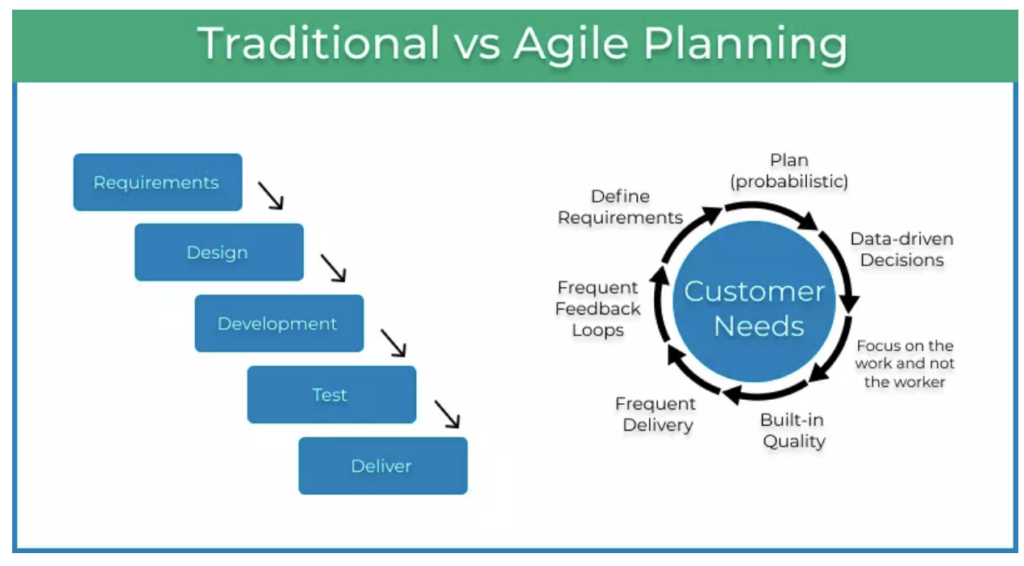The Complete Guide to Business Agility and Why It’s Important

Before 2020, Airbnb had a booming “Experiences” program where local residents designed and led unique activities for travelers, such as a food tour by bike or yoga with goats. They hosted tens of thousands of events in more than 1,000 cities around the globe. But then COVID-19 hit.
Airbnb could have waited until stay-at-home restrictions were lifted. Instead, in the face of government shutdowns, they quickly pivoted to offering Online Experiences in more than 30 countries, including tango lessons with a Latin Grammy nominee. This is just one example of how the pandemic has accelerated the pace of digital transformation across industries and heightened the need for business agility.
In a survey by Deloitte, 67% of the respondents agree that improving business agility is a high priority across the organization. However, almost 50% do not think they have a clear articulation of why, and only 24% of the respondents say the outcomes are measured and made transparent.
Organizations today are challenged with ensuring their workforce is not only practicing agile ways of working but also understanding why and how it impacts their business objectives.
To help leaders address this challenge, we’ll break down the concept of business agility, why it’s important, and what an agile strategy and methodology are below.
What is business agility?
Business agility refers to an organization’s ability to quickly and cost-effectively respond to market changes and emerging opportunities. These include industry trends, technological advances, customer needs, competitive threats, revenue opportunities, and workforce demands.
Agile organizations are more equipped to adapt to uncertain situations and changing market requirements, analyze and respond to internal or external opportunities and threats, and quickly deliver products and services of high value and quality.
There are subsets of business agility, like strategic agility, operational agility, and marketing agility which together help an organization adapt to the changing environment. Take the latter, for example. Marketers may plan campaigns, ads, social media posts, and events months in advance, but marketing agility — or agile marketing — can help them respond to unforeseen circumstances, like losing talent, shrinking budgets, or changing product messaging.
Components of Business Agility
Business agility is made up of five key components: leadership, governance, people, culture, and strategy. Each component influences how the organization operates and adapts to the changing needs of its customers and the market.
- Leadership: Agile leadership embodies communication, collaboration, and commitment. Rather than remain content with the traditional top-down bureaucratic approach, agile leaders focus on developing others as leaders to better work toward a shared purpose.
- Governance: Agile governance is characterized by transparency and consistency in how an organization’s objectives are set and achieved, how risk is managed, and how performance is optimized.
- People: Agile teams are motivated by autonomy, mastery, and purpose. They want to continuously develop their skills and learn how to work best together. Their key characteristics include being organized, analytical, resilient, innovative, and collaborative.
- Culture: An agile culture is characterized by a set of core values, behaviors, and practices that guide an organization through periods of volatility, uncertainty, and complexity. This type of culture promotes, encourages, and rewards the creativity and autonomy of its people.
- Strategy: Agile strategy is developed through an iterative and continuously evolving process. Rather than have one high-level plan to achieve one high-level objective, agile strategies are typically created in response to issues or events, regularly tested, and modified. We’ll talk about this more later.
Now that we have a better understanding of what business agility is, let’s look at why it’s important.
Why is agility important?
Business agility is key to competing in environments that are constantly changing due to technological and social forces like artificial intelligence and globalization.
Whether customer needs shift dramatically, disruptive technology emerges, or a new competitor enters the market, enterprises need agility to respond. Agile ways of working can help enterprises respond in a number of ways: by expanding their product lines, entering new markets, streamlining their supply chain operations, and more.
If the enterprise is able to respond quickly to meet customer demands, they’re more likely to retain those customers, compete, and thrive. Business agility can not only help organizations improve the customer experience — it can also help them improve the employee experience. Agile ways of working require cross-collaboration and autonomy, both of which can boost employee morale and productivity.
Let’s take a closer look at the agile methodology below to better understand the benefits of business agility.
Agile Methodology
The agile methodology originally applied to software development, but now applies more broadly to project management.
With this methodology, a cross-functional team cycles through a process of planning, executing, and evaluating in order to complete a project — whether that’s developing a new product or an employee wellness program. While a project lead may communicate the project requirements and decide what work should be prioritized, the team typically decides how the work will get done. Throughout the process, the team is continuously evaluating requirements, plans, and results, in order to respond to change quickly.
This iterative approach is very different from traditional planning. Also known as the waterfall methodology, traditional planning follows a linear progression. Each stage from the very beginning to the very end of a project is carefully planned out and documented, and one team must complete one stage of the project before another team can start another. This waterfall approach makes it harder to respond to change, incorporate customer feedback, and collaborate cross-functionally. That’s why many organizations are adopting an agile methodology.

In an organization, each team may adopt its own agile methodology or set of conventions that they agree to follow. That means every agile methodology is a bit different. However, they all share core values. These are:
- Focus on the people doing the work and how they work together over processes and tools.
- Prioritize delivering a working solution to customers’ pain points over creating hyper-detailed documentation.
- Value collaborating with team members and customers over negotiating contracts or SLAs.
- Concentrate on responding to change over following a predefined plan.
Agile Strategy
An agile strategy is designed to help an organization structure and operate in a way that allows it to create and respond to change and deal with uncertainty. This type of strategy enables an organization to frequently deploy initiatives while sustaining momentum towards its business objectives.
An agile strategy shifts an organization away from long-term planning to flexible and dynamic planning. It’s characterized by short development cycles, continuous feedback, and minimal overhead to facilitate rapid iteration and improvements of products.
To achieve true business agility, the entire organization must be informed, aligned, and committed to agile ways of working toward a shared vision. These ways of working cannot be dictated — instead, teams should have the autonomy to decide how to work to achieve their goals and ultimately the organization’s vision. This requires executive buy-in and sponsorship and a clear strategy.
Here are some tips for developing and executing an agile strategy:
1. Formalize a vision statement.
Where do you see your organization in the next year? What about five years? Ten years? With key stakeholders, you should formalize your company vision into a statement that can be easily shared with your employees and externally on your website, social media platforms, and other customer-facing assets.
This vision statement will act as your rallying point or destination for your agile strategy. The vision will tell you where to go, while the strategy will focus on the how.
2. Create a roadmap.
An agile strategy should not be too prescriptive by definition, but creating a roadmap can help you identify key goals that drive you toward your vision.
The purpose of this roadmap is to clearly align work with desired outcomes. Instead of focusing on deliverables and due dates, it should include enough detail to enable teams to kick off projects with confidence but be able to iterate later on. It should also include clear criteria for success as well as the desired outcomes. This will ensure that teams know whether to invest more time and resources into a project, or to rapidly iterate in order to achieve a particular outcome.
3. Continually execute.
Part of your roadmap should define a cadence for strategic planning and execution. How often should you meet to review initiatives and launch new ones? Monthly? Bimonthly? It should also define a communication plan to share updates on strategic planning and execution with the entire organization.
It’s important to note that this cadence and communication is for the entire organization. Agile teams should have the autonomy to decide how often they meet to discuss progress and ask for help and how they communicate on a project-by-project basis. Some teams may work best by having daily standups and communicating via Slack, while others may work best meeting every two weeks and assigning tasks and tracking progress in Asana.
4. Implement the strategy in one area.
One strategic agile learning from Andrew Karpie — an independent analyst and consultant in the contingent talent industry — is to identify an area where the agile strategy is most likely to be successful and implement it there. Then as the agile strategy proves its value, you can begin implementing it throughout more departments and levels of the company.
You can also address any issues as they arise in that one area. For example, if some employees were struggling with fear or uncertainty due to a lack of experience with agile ways of working, then you may provide more training and coaching to employees in other departments before you roll out the strategy there.
Agility Examples
Business agility can help organizations meet the changing needs of their customers and market by diversifying their services and products, entering new markets, or changing their product messaging — and these are just a few examples of what an agile company is capable of.
Below are real examples of companies using business agility to compete in times of great uncertainty and disruption.
1. Swiggy
Swiggy is one of India’s largest food-delivery startups. In 2020, their platform included more than 160,000 restaurants in 500 cities. These restaurants were mostly traditional “sit-down” restaurants that offered pick-up and delivery options. When lockdowns were enforced due to COVID-19, restaurant activity, including deliveries, fell by more than 50%.
Rather than continue to rely on restaurants with a fixed location as delivery partners, Swiggy added over 36,000 street food vendors in 125 cities to its platform. These vendors were then added to a new tab under the restaurant category of the app. This was an agile response to a change in consumer behavior regarding continued social distancing and heightened demand for online services, like food delivery, even after the restrictions were lifted. As a result of this and other new services like the grocery delivery service Instamart, Swiggy rebounded to about 90% of its pre-Covid-19 food delivery volumes.
2. Zoetis
Zoetis is a leading global-health company for animals. In the middle of the pandemic, they had to orchestrate the largest product launch in the history of the company in the middle of the pandemic. They faced challenges related to supply-chain disruptions, marketing delays, and reduced opening hours at testing centers and laboratories. They also were launching this product in 45 global markets where local government guidance was different. For example, social distancing regulations and requirements to wear protective clothing varied by location.
In response, Zoetis’ CEO Kristin Peck empowered local leaders across these 45 markets to conduct the launch in the way they thought best for their specific customers and employees. Peck offered some high-level guidance to ensure some consistency across the product launch, but local leaders as well as field-based employees had the autonomy to make decisions based on the unique circumstances of their market.
3. Evalueserve
Evalueserve is a mid-sized global IT services firm with offices around the world, including in India. When India declared a strict lockdown with six hours notice, Evalueserve had to shift almost all of its 3,000 employees from an in-office model to work-at-home model.
Understanding the increased risk to employee well-being and morale, Evalueserve kicked off several initiatives to strengthen the culture for remote employees. It added “no agenda check-in calls” to prioritize employees’ mental health and wellbeing while helping them maintain motivation. The company also changed its incentives to reward employees for learning and adaptability during this time of great uncertainty and disruption. As a result, during the period of lockdown, Evalueserve experienced negligible attrition of employees.
4. The Walt Disney Company
The Walt Disney Company was hit hard by the pandemic, but responded with agility to stave off the worst of the blows. For as long as they could, they kept their theme parks open in a limited capacity and added safety protocols for all facilities, staff, and guests. They laid off employees across its portfolio of stores, parks, and cruise ships.
They also reallocated resources and people to its Disney+ streaming service, which had launched in November 2019, to add new content to attract users. Throughout 2020 and 2021, they released hits like Pixar’s “Soul,” the second season of “The Mandalorian,” its first Marvel series “WandaVision,” and the live-action movie Mulan. By the end of 2021, Disney+ had more than 100 million paying subscribers. This not only significantly outperformed competitors HBO Max and Peacock, but also exceeded the goal it had hoped to meet by 2024. Disney has now forecast that the platform will have between 230 and 260 million subscribers by 2024.
What are the benefits of business agility?
Business agility can offer a wide range of benefits to customers and employees, many of which we’ve discussed above. Here is a recap of a few of the greatest benefits:
- High-value initiatives, including product features, are developed and delivered in shorter cycles.
- A culture of continuous improvement and innovation is fostered.
- Overhead decreases and efficiency increases.
- Project planning and tracking are easier.
- Employee satisfaction is higher due to increased collaboration and autonomy.
- More visibility into projects helps project managers catch any issues and executives make better, data-informed decisions.
What are the challenges of business agility?
Business agility does pose challenges as well. Below are a few of the greatest challenges that an organization may face on their journey to become agile.
1. Resistance to Change
While key stakeholders may understand the necessity of business agility, there will likely be some employees that resist because it represents a significant shift in ways of working. They may be suffering from change fatigue, or simply not understand why they have to change how they work.
If that’s an issue at your organization, continuously reinforce why you’re adopting agility. It 1) provides a competitive advantage, 2) enables faster time to market, 3) improves employee engagement and provides a sense of ownership of the work.
2. Lack of Commitment or Vision by Leadership
Leaders set an example for the entire organization. If they say they are working to instill a culture of continuous improvement and innovation but revert to legacy leadership styles and behaviors that are not aligned with that new culture, then this can hamper progress toward adopting agility principles and strategies.
To address this challenge, leaders must ensure their actions align with the organization’s vision and strategic goals. Agile leaders empower their direct reports and all employees to share their ideas and concerns, work autonomously, and learn from failures.
3. Skill Gaps
Another major challenge that can hinder agility adoption is a shortage of skilled personnel. When creating your vision statement and roadmap, you may discover that your workforce does not have the skills your business needs to meet your strategic goals.
If this is the case, then you can fill the gaps by offering training to upskill or reskill existing personnel or by leveraging flexible talent. For example, you may hire an independent consultant with skills you need for a certain project, like market research and growth, corporate strategy, or digital transformation.
The challenges of agility adoption are even greater for larger organizations with more people, processes, and systems: organizational resistance to change, difficulty scaling the transformation, and a lack of communication and collaboration.
However, organizations that can address and overcome these challenges will have a competitive advantage — and relatively quickly. In the Business Agility Institute’s 2021 Business Agility Report: Rising to the Challenge, the organizations with high business agility maturity said they saw significant benefits within two years of starting their transformation.
Becoming Agile Has Never Been More Important
Once only used to describe software development, agility is now a concept that applies to projects, processes, and operations across an enterprise. Business agility can help improve strategy development, execution, and decision-making and ultimately help an organization prepare for and respond to changes in their environment.
While adopting agile methodologies and practices may be intimidating if your organization has never done it before, it will help you work iteratively, deliver value to your customers, and embrace continuous improvement. Even adopting these principles in some areas while retaining more traditional business practices in other areas will help set your organization up for success.
Ready to learn how Catalant can keep you agile?
Let’s TalkRelated Articles
Share Article












